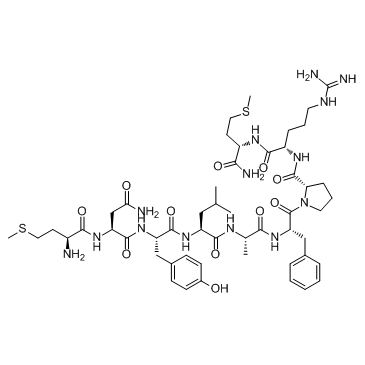Small Cardioactive Peptide B (SCPB)
Modify Date: 2024-01-03 10:08:42

Small Cardioactive Peptide B (SCPB) structure
|
Common Name | Small Cardioactive Peptide B (SCPB) | ||
|---|---|---|---|---|
| CAS Number | 84746-43-0 | Molecular Weight | 1141.41000 | |
| Density | 1.41 g/cm3 | Boiling Point | N/A | |
| Molecular Formula | C52H80N14O11S2 | Melting Point | N/A | |
| MSDS | N/A | Flash Point | N/A | |
| Purity | Quantity | Budget | Inquiry |
|---|
Use of Small Cardioactive Peptide B (SCPB)Small Cardioactive Peptide B (SCPB), a neurally active peptide, stimulates adenylate cyclase activity in particulate fractions of both heart and gill tissues with EC50s of 0.1 and 1.0 μM, respectively. |
| Name | scpb |
|---|---|
| Synonym | More Synonyms |
| Description | Small Cardioactive Peptide B (SCPB), a neurally active peptide, stimulates adenylate cyclase activity in particulate fractions of both heart and gill tissues with EC50s of 0.1 and 1.0 μM, respectively. |
|---|---|
| Related Catalog | |
| Target |
EC50: 0.1 μM (adenylate cyclase, in heart tissues), 1.0 μM (adenylate cyclase, in gill tissues)[1] |
| In Vitro | Small cardioactive peptide B (SCPB) is a neurally active peptide endogenous to Aplysia. Small cardioactive peptide B (SCPB) possesses cardioexcitatory effects in Aplysia and reported a threshold concentration of 0.01 nM for both native and synthetic Small cardioactive peptide B (SCPB) stimulated effects on the isolated heart. Effects of Small Cardioactive Peptide B (SCPB) on the physiology of the isolated heart and gill preparations from the mollusc Aplysia californica were examined. In addition, the effects of Small Cardioactive Peptide B (SCPB) and FMRFamide (Phe-Met-Arg-Phe-NH2) on adenylate cyclase activity are compared in particulate fractions of heart and gill tissues, respectively. Small Cardioactive Peptide B (SCPB) is found to exert dose-dependent, reversible changes in cardiac activity when perfused through the isolated heart. The EC50 values effecting changes in heart rate and force of contraction are 0.03 and 0.3 nM, respectively; minimum concentrations find to effect changes in heart rate and force of contraction are normally 0.001 and 1 pM, respectively. When perfused through the isolated gill, Small Cardioactive Peptide B (SCPB) is found to suppress the gill withdrawal response amplitude with a threshold concentration of 0.01 pM and an EC50 value of 0.03 nM. Suppression of the gill withdrawal response amplitude by Small Cardioactive Peptide B (SCPB)is found to be dose dependent and reversible up to a concentration of 1nM. At higher concentrations, the suppression tended to persist irreversibly. Small Cardioactive Peptide B (SCPB) stimulates adenylate cyclase activity in particulate fractions of both heart and gill tissues with an EC50 of 0.1 and 1.0μM, respectively[1]. |
| References |
| Density | 1.41 g/cm3 |
|---|---|
| Molecular Formula | C52H80N14O11S2 |
| Molecular Weight | 1141.41000 |
| Exact Mass | 1140.56000 |
| PSA | 468.94000 |
| LogP | 4.05150 |
| Index of Refraction | 1.656 |
| Storage condition | 2-8℃ |
| WGK Germany | 3 |
|---|
| met-asn--leu-ala-phe-pro-arg-met (met-asn-tyr-leu-ala-phe-pro-arg-met amide) |
| small cardioactive peptide b |
| cardioactive peptide b (small) |
| h-met-asn-tyr-leu-ala-phe-pro-arg-met-nh2 |
| met-asn-tyr-leu-ala-phe-pro-arg-met amide |
| met-asn-tyr-leu-ala-phe-pro-arg-met-nh2 |
| mnylafprm-nh2 |
| MET-ASN-TYR-LEU-ALA-PHE-PRO-ARG-MET-NH2 |
| Small Cardioactive Peptide B (SCPB) |

